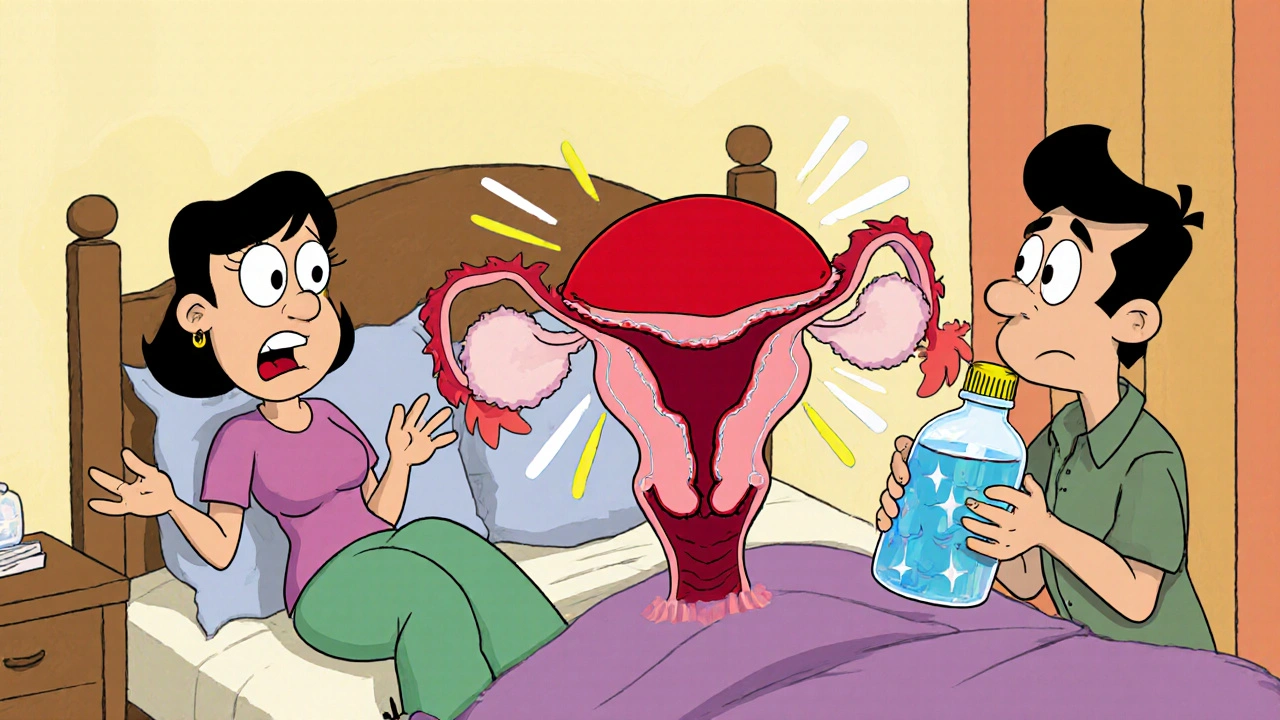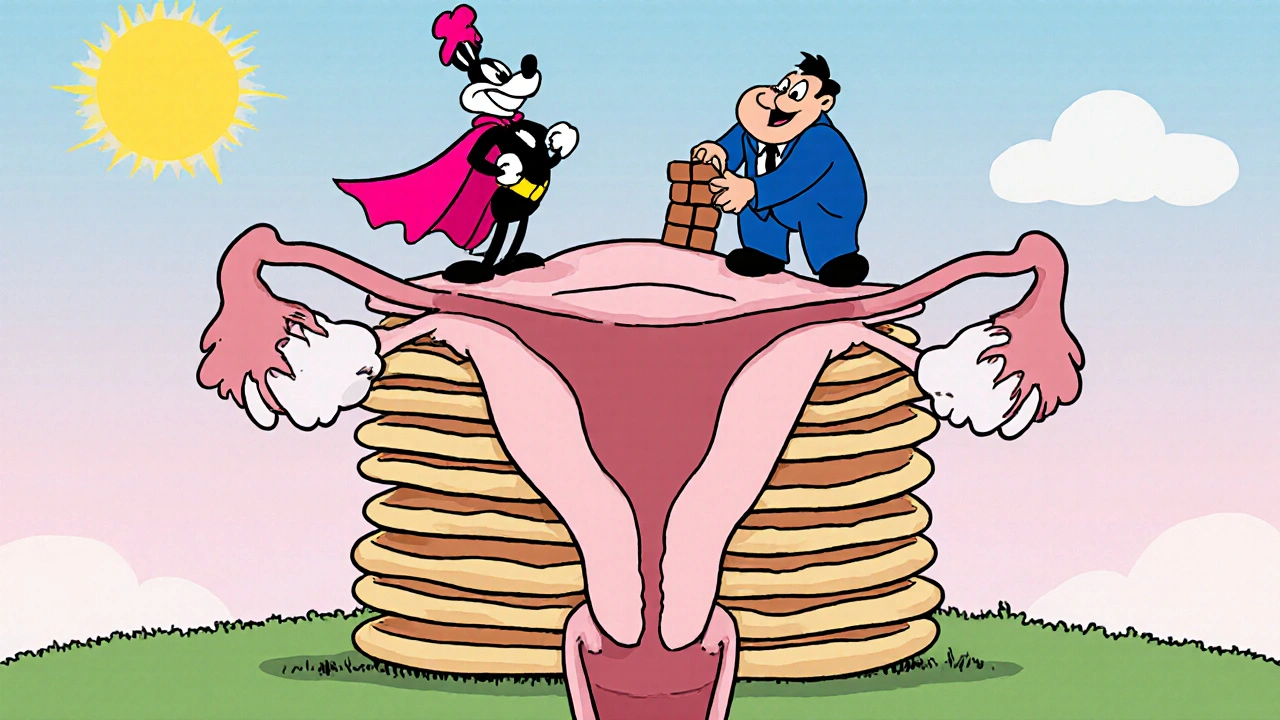Endometrial Hyperplasia Symptom Checker
Assess Your Symptoms
This tool helps identify potential symptoms related to uterine lining overgrowth. It is not a diagnostic tool, but can help determine if you should consult a healthcare provider.
Results
Select your symptoms to see your assessment
Ever wondered why a seemingly unrelated gynecological issue could throw a wrench into your bedroom? When the lining of the uterus grows too thick-medically known as Endometrial hyperplasia is a condition where the endometrium (uterine lining) proliferates excessively, often because of hormonal imbalance-it can change how you feel during intimacy. Let’s break down what’s happening, why it matters for your sex life, and what you can actually do about it.
What Is Uterine Lining Overgrowth?
In plain terms, the uterus is lined with a tissue that thickens each month to prepare for a potential pregnancy. When that tissue keeps growing without shedding, it becomes Uterine lining overgrowth a state where the endometrial layer expands beyond its normal thickness, often measured by ultrasound or biopsy. The medical name for this is endometrial hyperplasia, and it’s usually driven by too much estrogen or not enough progesterone.
Why Does Hormone Balance Matter?
Estrogen fuels the growth of the uterine lining, while progesterone tells it to stop and shed. When estrogen dominates-whether because of obesity, polycystic ovary syndrome (PCOS), or hormone‑replacement therapy-the lining can keep expanding.
- Estrogen the primary female sex hormone that stimulates endometrial proliferation
- Progesterone the hormone that counteracts estrogen, promoting shedding of the endometrium
- Polycystic ovary syndrome (PCOS) a hormonal disorder characterized by excess androgen and estrogen, often leading to irregular periods and endometrial overgrowth
- Menopause the natural decline of ovarian hormone production, which can cause fluctuating estrogen levels and affect the endometrium
When these hormones are out of sync, the lining doesn’t shed properly, and the excess tissue can cause a host of symptoms that directly impact intimacy.
How Overgrowth Shows Up in the Bedroom
Here’s the uncomfortable truth: a thickened lining can make sex painful and less enjoyable. The most common ways it shows up are:
- Pain during intercourse (dyspareunia) - The overgrown tissue can be tender, especially after a period or during ovulation, turning pleasure into discomfort.
- Vaginal dryness - Hormonal imbalances that cause the lining to grow often also reduce natural lubrication, making friction feel harsh.
- Decreased libido - Chronic pelvic pain or the anxiety of anticipating pain can dampen sexual desire.
- Irregular bleeding - Spotting or heavy periods can interrupt intimate moments and create emotional stress.
These symptoms don’t just affect you physically; they can strain relationships, create feelings of embarrassment, and even lead to avoidance of intimacy altogether.
Getting a Diagnosis: What to Expect
If you suspect your sex life is suffering because of uterine lining overgrowth, a proper diagnosis is essential. Here’s the typical pathway:
- Pelvic exam a physical examination where the doctor feels the uterus and ovaries for abnormalities
- Transvaginal ultrasound an imaging test that measures the thickness of the endometrium
- Endometrial biopsy a minor procedure where a small tissue sample is taken for microscopic analysis
Doctors look for a lining thicker than 5mm in post‑menopausal women or irregular thickening in pre‑menopausal patients. If the biopsy shows atypical cells, there’s a higher risk of progressing to cancer, making early detection crucial.

Comparison of Common Symptoms
| Feature | Normal Lining | Overgrowth (Hyperplasia) |
|---|---|---|
| Thickness (post‑menopause) | ≤5mm | >5mm, often 7-12mm |
| Bleeding pattern | Regular monthly period | Irregular spotting or heavy bleeding |
| Pain during sex | Usually none | Common (dyspareunia) |
| Vaginal dryness | Varies with cycle | Often increased due to hormonal imbalance |
Treatment Options That Can Restore Comfort
Good news: most cases are treatable, and many women see big improvements in both pelvic health and sexual function.
- Progestin therapy - Daily pills, injections, or a levonorgestrel‑releasing intrauterine device (IUD) provide progesterone directly to the lining, prompting it to thin.
- Weight management - Losing even 5-10% of body weight can lower estrogen produced by fat cells, helping balance hormones.
- Addressing underlying conditions - Managing PCOS, thyroid disorders, or diabetes often reduces estrogen excess.
- Surgical options - In severe cases, a dilation and curettage (D&C) or hysterectomy may be recommended.
Most doctors start with the least invasive approach-usually a hormonal IUD-because it also offers reliable contraception, which many patients appreciate.
Keeping Your Sex Life Healthy While Treating
Even before treatment fully kicks in, you can take steps to protect intimacy:
- Open communication - Let your partner know what you’re experiencing; a supportive partner can reduce anxiety.
- Use lubricants - Water‑based or silicone gels can compensate for dryness and reduce friction.
- Pelvic floor therapy - A physical therapist trained in women's health can teach exercises that relax pelvic muscles and improve blood flow.
- Plan around your cycle - If you notice pain spikes after periods, schedule intimate moments for days when you feel better.
- Mind‑body techniques - Deep breathing, guided imagery, or yoga can lower stress hormones that otherwise aggravate pain.
These practical tips often make a noticeable difference while you wait for hormonal therapy to thin the lining.
When to Seek Immediate Help
While most overgrowth cases are benign, watch for red‑flag symptoms that require urgent evaluation:
- Sudden, heavy bleeding that soaks a pad every hour.
- Pelvic pain that wakes you from sleep.
- Fever or foul‑smelling discharge-possible infection.
- Any biopsy result indicating atypical cells or early cancer signs.
If you experience any of these, call your gynecologist right away. Early intervention can prevent complications and keep your overall health on track.
Bottom Line
Uterine lining overgrowth isn’t just a “medical” issue; it’s a factor that can reshape how you feel in intimate moments. By understanding the hormone dynamics, getting an accurate diagnosis, and tackling the problem with both medical and lifestyle strategies, you can reclaim comfort and pleasure. Remember: you don’t have to suffer in silence-talk to a health professional, keep the conversation open with your partner, and take proactive steps toward a healthier sex life.
Frequently Asked Questions
Can endometrial hyperplasia cause infertility?
Yes. Excessive lining can interfere with embryo implantation and may be linked to irregular ovulation, making conception harder. Treating the hyperplasia often restores normal menstrual cycles and improves fertility chances.
Is a hormonal IUD the best first‑line treatment?
For many women, a levonorgestrel IUD is preferred because it delivers progesterone directly, thins the lining, and provides effective birth control. It’s less invasive than daily pills and often has fewer systemic side effects.
How long does it take for the lining to return to normal after treatment?
Typically 3-6 months of consistent progestin therapy are needed for the endometrium to thin to a healthy thickness. Follow‑up ultrasounds will confirm progress.
Will lifestyle changes alone fix the problem?
Lifestyle tweaks-weight loss, balanced diet, and stress management-can dramatically improve hormone balance, but many women still need medical therapy for a full resolution.
Is dyspareunia always a sign of overgrowth?
No. Painful intercourse has many causes, including infections, pelvic floor tension, or vaginal atrophy. A thorough exam distinguishes whether the uterine lining is involved.


Macy-Lynn Lytsman Piernbaum
Wow, I had no idea thickened lining could ruin the vibe 😳
Alexandre Baril
You’re right, balancing estrogen and progesterone is key. A lot of women find progestin therapy helpful and relatively easy to start.
Grant Wesgate
Totally agree, using a water‑based lube can make things much more comfortable while you wait for the lining to thin 😊
benjamin malizu
While the article correctly outlines the pathophysiology, it glosses over the oncogenic potential of atypical hyperplasia. The failure to emphasize serial endometrial sampling may lead to under‑recognition of progression to endometrioid carcinoma.
Maureen Hoffmann
It’s crazy how a condition that sounds so clinical can spill over into the bedroom in such a personal way. When the endometrium gets too thick, even light touch can become a source of cramping and alarm. Many women report that during ovulation the overgrown tissue feels tender, turning what should be a pleasurable moment into a grimace. The hormonal imbalance also often leads to reduced natural lubrication, which adds friction and discomfort. This combo can create a feedback loop where fear of pain reduces desire, and lower desire can further mess with hormone cycles. The article points out that talk with a partner is vital; I’ve seen couples regain intimacy simply by sharing what feels good and what doesn’t. Progestin therapy, especially with a levonorgestrel IUD, can thin the lining within a few months, and many report a noticeable drop in dyspareunia. Weight loss, even modest, can decrease estrogen production from adipose tissue, giving the progesterone a better shot at doing its job. Pelvic floor physical therapy can also help relax muscles that have tightened in response to chronic pain. Mind‑body practices like yoga and deep breathing lower stress hormones, which can otherwise keep estrogen levels high. Keeping a symptom diary can help you and your doctor track what triggers flare‑ups and what alleviates them. Regular follow‑up ultrasounds confirm that the lining is responding, giving confidence that the treatment is on track. If medication isn’t enough, a D&C can reset the uterine environment, though it’s more invasive. Ultimately, a multi‑pronged approach-medical, lifestyle, and communication-offers the best chance of reclaiming a satisfying sex life. Remember, you’re not alone; many have walked this path and found relief. Stay patient and proactive, and you’ll likely see improvement.
Alexi Welsch
One might argue that lifestyle modifications alone are insufficient; the hormonal milieu often requires pharmacologic intervention to achieve durable remission.
George Kata
Yo, I’ve been on the levonorgestrel IUD for six months, and honestly my period’s now super light, so the pain’s dropped big time.
Nick Moore
Keep your head up! Small weight loss and consistent yoga can shift the estrogen‑progesterone balance in your favor.
Jeffery Reynolds
It’s “hyperplasia,” not “hyperplasy.” Also, “its” should be “it’s” when meaning “it is.”
Mitali Haldankar
Thanks for the thorough rundown! I’ll definitely talk to my doc about an IUD 🤗
snigdha rani
Oh great, another reminder that my uterus is basically a pastry that won’t stop rising. Fantastic.
Mike Privert
Hey, don’t let the sarcasm get you down. Many find that a combination of diet tweaks and a progestin IUD does the trick.
Veronica Lucia
Considering the potential for malignant transformation, regular follow‑up ultrasounds seem prudent.
Sriram Musk
Indeed, surveillance is essential, especially after any atypical biopsy finding.
allison hill
Honestly, I think the medical community over‑medicalizes what could be managed with natural hormone regulation.